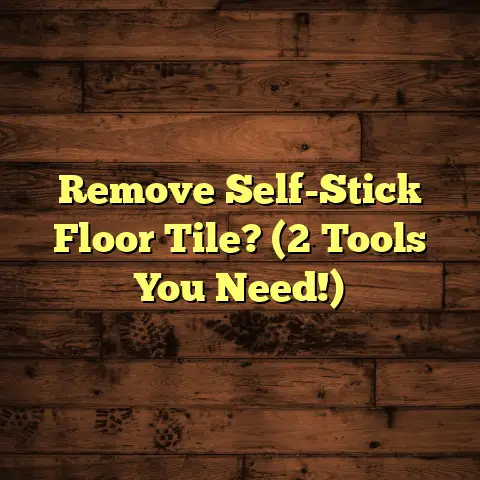Remove Fabuloso From Wood? (6 Steps Before It’s Ruined!)
(6 Steps Before It’s Ruined!)
I’ve seen it all, trust me, from water damage catastrophes to pet stain nightmares.But one issue that keeps popping up, especially with the rise in popularity of multi-purpose cleaners, is the accidental (or sometimes not-so-accidental) use of products like Fabuloso on wood floors.
We’re all becoming more aware of the products we’re using in our homes. Eco-friendly cleaning is no longer a trend; it’s a necessity. We want biodegradable, non-toxic options that keep our families (and our pets!) safe.
But here’s the thing: that vibrant, sweet-smelling Fabuloso you love for cleaning your bathroom might be slowly destroying your beautiful wood floors.
I’m here to tell you why, and more importantly, what to do if you’ve already made the mistake of using it. Time is of the essence here. We need to act before irreversible damage occurs.
Section 1: Understanding Fabuloso and
Its Components
So, what exactly is Fabuloso?
It’s a hugely popular multi-purpose cleaner known for its powerful fragrance and ability to clean a variety of surfaces – from tile and linoleum to countertops and sinks. You see it everywhere, right?
But let’s peek under the hood and see what makes it tick. Fabuloso’s chemical composition typically includes water, surfactants (cleaning agents), fragrance, coloring agents, preservatives, and pH adjusters.
The exact formula varies slightly depending on the scent, but the core ingredients remain consistent.
Now, here’s where the trouble starts. Those surfactants, designed to lift dirt and grease, can be harsh on wood finishes. The pH adjusters, meant to optimize cleaning power, can also strip away the protective layer on your floors.
And that amazing fragrance? It often comes from synthetic chemicals that can interact negatively with wood over time.
I’ve personally seen cases where regular Fabuloso use has led to:
-
Discoloration: The wood loses its natural color and appears bleached or faded.
-
Warping: The wood absorbs too much moisture, causing it to swell and warp.
-
Finish Damage: The protective layer is stripped away, leaving the wood vulnerable to scratches, stains, and further damage.
Think of your wood floor finish like a shield. It protects the wood underneath from moisture, dirt, and everyday wear and tear. Fabuloso, in many cases, acts like an acid, slowly eating away at that shield.
Here’s a table showing common Fabuloso ingredients and their potential impact on wood:
| Ingredient | Potential Impact on Wood |
|---|---|
| Surfactants | Can strip away the protective finish, leading to dullness and increased susceptibility to scratches and stains. |
| pH Adjusters | Can alter the pH of the wood surface, potentially causing discoloration or weakening the wood fibers. |
| Fragrance | Synthetic fragrances can contain chemicals that react with the wood finish, leading to discoloration or a sticky residue. |
| Coloring Agents | Can stain or discolor the wood, especially if the finish is already compromised. |
| Preservatives | Some preservatives can be harsh and may contribute to the breakdown of the wood finish over time. |
| Water | Excessive water exposure, especially if the finish is damaged, can lead to warping, swelling, and the growth of mold or mildew. |
| Overall Effect | Regular use can degrade the finish, alter the wood’s appearance, and compromise its structural integrity. |
Section 2: Identifying Damage Caused
by Fabuloso
Okay, so you suspect Fabuloso might be the culprit behind your floor’s woes. What are the telltale signs?
-
Dullness: This is often the first and most noticeable sign. The floor simply doesn’t have the same shine it used to.
-
Sticky Residue: Fabuloso can leave behind a sticky film that attracts dirt and makes the floor feel unpleasant to walk on.
-
Discoloration: Look for light spots, faded areas, or even a yellowish tinge.
-
Water Spots: If the finish is compromised, water can penetrate the wood, leaving behind unsightly water spots.
-
Peeling or Cracking Finish: In severe cases, the finish might start to peel or crack, exposing the raw wood underneath.
Before you panic, take a deep breath and assess the extent of the damage. Is it just a small area, or is the entire floor affected? Are the signs subtle, or is the damage obvious?
A simple test is to run your hand over the surface. Does it feel smooth, or does it feel rough or sticky?
You can also try applying a small amount of wood cleaner to an inconspicuous area. If the cleaner quickly absorbs into the wood, it’s a sign that the finish is compromised.
I remember one client, Mrs. Davis, who called me in a frenzy. She had been using Fabuloso on her hardwood floors for years, thinking it was a safe and effective cleaner.
“My floors look terrible!” she exclaimed. “They’re dull, sticky, and there are these weird light spots everywhere!”
After inspecting her floors, it was clear that Fabuloso had stripped away the finish, leaving the wood vulnerable to damage. We ended up having to refinish the entire floor, a costly and time-consuming process.
Mrs. Davis’ story is a cautionary tale. Prompt action is crucial. The sooner you address the issue, the better your chances of saving your floors.
Section 3: Preparing for Removal
Alright, you’ve identified the damage, and you’re ready to take action. Here’s what you’ll need to gather:
-
Eco-Friendly Wood Cleaner: I’m a big fan of products that are specifically designed for wood floors and are free of harsh chemicals. Look for terms like “pH-neutral,” “biodegradable,” and “non-toxic” on the label.
-
Two Buckets: One for clean water and one for your cleaning solution.
-
Soft Microfiber Cloths: These are gentle on wood and won’t scratch the surface.
-
Soft-Bristled Brush (Optional): For scrubbing stubborn residue.
-
Wood Conditioner or Oil: To restore luster and protect the wood after cleaning.
-
Ventilation: Open windows and doors to ensure good airflow.
-
Protection: Cover any nearby furniture or rugs to prevent them from getting wet.
Gathering the right cleaning supplies is paramount. I always recommend opting for non-toxic and biodegradable options. Why? Because they’re safer for your family, your pets, and the environment.
Plus, many eco-friendly cleaners are just as effective as their chemical-laden counterparts. Don’t be fooled by marketing hype; read the labels and do your research.
Section 4: Step-by-Step Guide to Removing
Fabuloso from Wood
Okay, let’s get down to business. Here’s my tried-and-true method for removing Fabuloso from wood floors:
1. Initial Cleaning
Start by gently wiping down the surface with a damp (not soaking wet!) microfiber cloth. This will remove any loose dirt and debris and help to loosen the Fabuloso residue.
Make sure to wring out the cloth thoroughly to avoid over-wetting the floor. You want the cloth to be damp, not dripping.
2. Rinsing
Next, rinse the area with clean water. Again, use a damp cloth and wring it out frequently. You want to remove any remaining Fabuloso residue without saturating the wood.
This step is crucial because Fabuloso can leave behind a soapy film that attracts dirt and dulls the finish.
3. Gentle Scrubbing
If the residue is stubborn, you can use a soft-bristled brush or sponge with a mild, eco-friendly cleaner.
Mix the cleaner according to the manufacturer’s instructions. Apply a small amount to the affected area and gently scrub in a circular motion.
Be careful not to apply too much pressure, as this could damage the finish. The goal is to lift the residue, not to sand the floor.
4. Drying
This is arguably the most important step. Thoroughly drying the area is essential to prevent moisture damage.
Use a clean, dry microfiber cloth to wipe up any remaining water. You can also use a fan to speed up the drying process.
Make sure the floor is completely dry before moving on to the next step.
5. Conditioning
Once the floor is dry, apply a wood conditioner or oil to restore luster and protect the wood.
Choose a product that is specifically designed for your type of wood floor. Follow the manufacturer’s instructions carefully.
Apply a small amount of conditioner or oil to a clean microfiber cloth and rub it into the wood in a circular motion. Allow it to sit for a few minutes, then wipe away any excess.
This step will help to replenish the natural oils in the wood and protect it from future damage.
6. Final Inspection
Finally, inspect the area for any remaining residue. If you see any, repeat steps 1-5.
You may need to repeat the process several times to completely remove the Fabuloso residue.
Be patient and persistent. It’s better to take your time and do it right than to rush the process and risk further damage.
Section 5: Preventative Measures for
Future Care
Now that you’ve successfully removed the Fabuloso, let’s talk about preventing this from happening again.
-
Choose Safe Cleaning Products: This is the most important step. Always use cleaning products that are specifically designed for wood floors. Avoid products that contain harsh chemicals, such as ammonia, bleach, or solvents.
-
Regular Maintenance: Regular sweeping or vacuuming will help to remove dirt and debris that can scratch the finish.
-
Appropriate Cleaning Techniques: When cleaning your wood floors, always use a damp (not soaking wet!) mop or cloth. Avoid using excessive water, as this can damage the wood.
-
Test New Products: Before using a new cleaning product on your entire floor, test it on an inconspicuous area first. This will help you to identify any potential problems before they become widespread.
-
Read Labels Carefully: Always read the labels of cleaning products carefully. Pay attention to the ingredients and the manufacturer’s instructions.
I always tell my clients, “An ounce of prevention is worth a pound of cure.” Taking these simple steps will help to protect your wood floors and keep them looking beautiful for years to come.
Conclusion
So, there you have it – my comprehensive guide to removing Fabuloso from wood floors.
Remember, acting quickly is key. The sooner you address the issue, the better your chances of saving your floors.
And don’t forget the importance of using eco-friendly alternatives. Not only are they safer for your family and the environment, but they’re also often just as effective as their chemical-laden counterparts.
By adopting safer cleaning habits, you can preserve the beauty and longevity of your wood floors for years to come.
Happy cleaning! And if you ever have any flooring questions, don’t hesitate to reach out. I’m always here to help.





